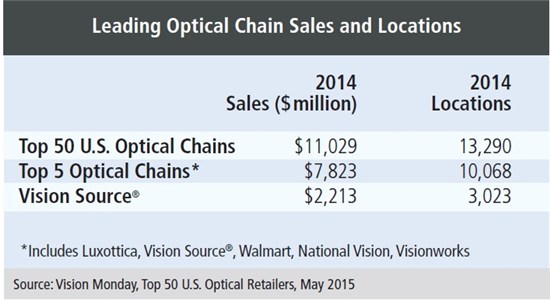By ROB Editors
July 6, 2016
Excerpted from the newly published 2016 version of Vision Source’s Navigation Guide to MEGATRENDS in Eyecare Practice: A 20-page report outlining marketing forces and consumer behavior affecting the profession now and in the future. Included are implications for ODs and action steps to capture opportunities.
 Over the past decade there has been an explosion of education programs for OD-owners dealing with business management principles and techniques – all designed to improve competitiveness in an increasingly challenging environment.
Over the past decade there has been an explosion of education programs for OD-owners dealing with business management principles and techniques – all designed to improve competitiveness in an increasingly challenging environment.
The upsurge in business education for ODs continues as more and more progressive ODs recognize that, in the face of challenges from commercial eyecare and managed care companies, their continued prosperity depends on better management.
Increased OD adoption of proven business management techniques is being caused in part by the long?term trend of consolidation of optometric practices. Over the long term, the number of practices operated by a single OD owner has steadily declined. Most independent practice ODs now work in multi-OD practices. The consolidation trend is driven by:
OPTIMIZED ECONOMIES OF SCALE. Economies of scale are available to multi-OD practices (occupancy, cost-of-goods, inventory, equipment, overhead, etc.).
IMPROVED BUSINESS MANAGEMENT. Multi-OD practices have a heightened ability to allocate time to financial management, marketing and staff training and supervision.
DELEGATED ADMINISTRATIVE TASKS. Increased administrative burdens of managed care are better absorbed in multi-OD practices.
ABILITY TO OFFER GREATER CONVENIENCE. Multi-OD practices are able to offer more convenient office hours and greater appointment availability.
ABILITY TO BETTER TRACK NUMBERS. Increased use of performance tracking programs that facilitate dashboard management.
Multi-doctor practices with larger patient bases and larger staffs require more attention to systemization and documentation of internal processes. This heightens
interest in business management education among this class of owners.
Over the past 30 years, there has been continuous consolidation among optical retail chains. This trend further exposes management deficiencies of independent ODs. A handful of large chains now control a dominant market share. The top five chains operate 10,068 locations in the U.S., and in 2014, accounted for 71 percent of total chain optical sales. Survivor chain optical organizations have greater financial and management resources to devote to improvement of their business models and are able to innovate new store formats and new merchandising and marketing programs that make them even more formidable competitors. The consolidation trend among corporate
providers, as well as a growing set of regulatory requirements, increases pressure on independents to maximize their value propositions.
Despite the proliferation of business education programs for ODs, many ODs continue to view themselves as chief clinicians of the practice, and not as CEOs. Many have not yet adopted basic management techniques used by all large corporations and many small businesses. For example:
 SET PRACTICE PERFORMANCE BENCHMARKS. A significant proportion of OD practices do not establish quantitative performance goals, and a majority have no written revenue and expense budget.
SET PRACTICE PERFORMANCE BENCHMARKS. A significant proportion of OD practices do not establish quantitative performance goals, and a majority have no written revenue and expense budget.
CREATE MARKETING PLANS. Only a minority of independent practices develop an annual written marketing plan, and most spend less than 2 percent of revenue to market their practices.
EXAMINE KEY METRICS. Review of key business metrics is sporadic in many practices. Many business decisions are based on guesstimates, biases and assumptions and not on data analysis.
FOCUS ON PATIENT. Few practices have developed and continuously reinforce an inspiring, patient-centric mission statement that improves staff behavior.
BETTER ENGAGE STAFF. Most OD owners spend little time to build staff engagement.
ENHANCE PATIENT EXPERIENCE. Most ODs do not consistently measure the patient experience and apply findings to actively coach staff in continuously improving
patient interactions.
Implications for Optometry
CREATE CONSISTENT PROCESSES. Independent OD practices must adopt disciplined management processes or they will experience increased jeopardy as managed care extends its dominance in eyecare and as commercial competition intensifies.
INCREASE EFFICIENCY. Practice valuation will be on the effectiveness of internal processes and staff to generate a growing stream of net income.
EXPAND BUSINESS RESOURCES. Optometric alliances will remain at the forefront of business education for independent ODs. Major alliances have growing financial resources and are adding staff to increase practice management offerings and personalized consulting for members. Membership opens the door to these resources.
Action Steps
TRACK PRACTICE PERFORMANCE. Annually, list key practice performance goals, and engage staff in tracking improvements in the patient experience score, reducing employee turnover, enhancing revenue per patient, improving accounts receivables and the operating margin of the practice, etc.
INCREASE EDUCATIONAL OPPORTUNITIES. Attend practice management lectures at major conventions and association meetings.
ENHANCE BUSINESS SAVVY. As an OD alliance member, take full advantage of business education programs offered by the alliance.
SHARE WITH PEERS. Participate in peer-sharing opportunities through OD alliances and at professional meetings and through peer study groups.
USE METRICS TO IMPROVE & SHARE WITH STAFF. Adopt systems that auto-track metrics, and display them on a management dashboard.

























